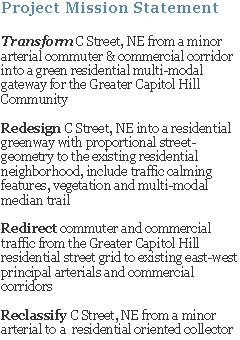
The above street cross-section is one type of bike lane configuration DDOT is considering as the DC creates a more city-wide bicycle-friendly infrastructure. This section would not necessarily be a direct application to C Street, NE. This type of configuration is more suited for commercial, high-density opposed to residential medium density. In short, asymmetrical to symmetrical layouts. Also, the example section is approximately 65ft wide (sidewalk curb to sidewalk curb) and C Street is approximately 90ft wide.
Refer to the post, "NYC Gets Its First-Ever Physically-Separated Bike Path" on StreetsBlog dated 09/20/07 for more information on this type of bike-lane configuration.
Below are several items Allan considers beneficial to the above street-scape cross-section:
1. You don’t have to cross traffic to enter a median bike path.
o This [raised center median path] would require having to retime the signals in the corridor to provide bike/ped only time to cross into the center median bike path.
o This [crossing traffic lanes to enter a raised center median path] could also raise serious safety issues.
o It [physically separated bike lane] would also be able to tie in easier to the Anacostia Trail by either continuing on the same side or only crossing C St NE once.
2. Safety would be increased since:
o you would not be in between two directions of traffic [raised center median path scenario]
o the street layout [physically separated bike lane] would be grade separated and protected by a line of parked cars. (sidewalk, planted strip, bike path, planted strip, parking lane, two lanes of traffic, planted median, two lanes of traffic, parking lane, bike path, sidewalk) This is just one potential layout of the right-of-way.
3. Being in between two directions of traffic would expose bikers/pedestrians to heavier amounts of noise and exhaust. [raised center median path scenario]
4. This is more in line with bike path planning and trends around the world and potentially in DC. [physically separated bike lane]
Please post your thoughts on either a "raised center median path", a " physically separated path" or some other potential design. Consider a design layout that would essentially connect and extend the recently constructed Anacostia River Trail (ART) at the northeast corner of C & 21st Street, NE.






